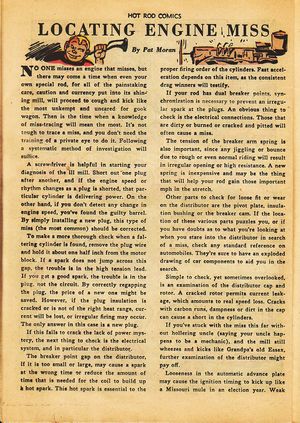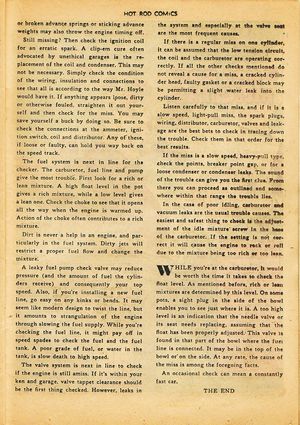|
By accessing or using The Crittenden Automotive Library™/CarsAndRacingStuff.com, you signify your agreement with the Terms of Use on our Legal Information page. Our Privacy Policy is also available there. |

Locating Engine Miss
|
|---|
|
|
Locating Engine Miss
Pat Moran
Hot Rod Comics #6
December 1952
No one misses and engine that misses, but there may come a time when even your own special rod, for all of the painstaking care, caution and currency put into its shining mill, will proceed to cough and kick like the most unkempt and uncared for gook wagon. Then is a time when a knowledge of miss-tracing will mean the most. It's not enough to trace a miss, and you don't need the training of a private eye to do it. Following a systematic method of investigation will suffice.
A screwdriver is helpful in starting your diagnosis of the ill mill. Short out one plug after another, and if the engine speed or rhythm changes changes as a plug is shorted, that particular cylinder is delivering power. On the other hand, if you don't detect any change in engine speed, you've found the guilty barrel. By simply installing a new plug, this type of miss (the most common) should be corrected.
To make a more thorough check when a faltering cylinder is found, remove the plug wire and hold it about one half inch from the motor block. If a spark does not jump across this gap, the trouble is in the high tension lead. If you get a good spark, the trouble is in the plug, not the circuit. By correctly regapping the plug, the price of a new one might be saved. However, if the plug insulation is cracked or is not of the right heat range, current will be lost, or irregular firing may occur. The only answer in this case is a new plug.
If this fails to crack the lack of power mystery, the next thing is to check the electrical system, and in particular the distributor.
The breaker point gap on the distributor, if it is too small or large, may cause a spark at the wrong time or reduce the amount of time that is needed for the coil to build up a hot spark. This hot spark is essential to the proper firing order of the cylinders. Fast acceleration depends on this item, as the consistent drag winners will testify.
If your rod has dual breaker points, synchronization is necessary to prevent an irregular spark at the plugs. An obvious thing to check is the electrical connections. Those that are dirty or burned or cracked and pitted will often cause a miss.
The tension of the breaker arm spring is also important, since any jiggling or bounce due to rough or even normal riding will result in irregular opening or high resistance. A new spring is inexpensive and may be the thing that will help your rod gain those important mph in the stretch.
Other parts to check for loose fit or wear on the distributor are the pivot plate, insulation bushing or the breaker cam. If the location of these various parts puzzles you, or if you have doubts as to what you're looking at when you stare into the distributor in search of a miss, check any standard reference on automobiles. They're sure to have an exploded drawing of car components to aid you in the search.
Simple to check, yet sometimes overlooked, is an examination of the distributor cap and rotor. A cracked rotor permits current leakage, which amounts to real speed loss. Cracks with carbon runs, dampness or dirt in the cap can cause a short in the cylinders.
If you've stuck with the miss this far without hollering uncle (saying your uncle happens to be a mechanic), and the mill still wheezes and kicks like Grandpa's old Essex, further examination of the distributor might pay off.
Looseness in the automatic advance plate may cause the ignition timing to kick up like a Missouri mule in an election year. Weak or broken advance springs or sticking advance weights may also throw the engine timing off.
Still missing? Then check the ignition coil for an erratic spark. A clip-em cure often advocated by unethical garages is the replacement of the coil and condenser. This may not be necessary. Simply check the condition of the wiring, insulation and connections to see that all is according to the way Mr. Hoyle would have it. If anything appears loose, dirty or otherwise fouled, straighten it out yourself and then check for the miss. You may save yourself a buck by doing so. Be sure to check the connections at the ammeter, ignition switch, coil and distributor. Any of these, if loose or faulty, can hold you way back on the speed track.
The fuel system is next in line for the checker. The carburetor, fuel line and pump give the most trouble. First look for a rich or lean mixture. A high float level in the pot gives a rich mixture, while a low level gives a lean one. Check the choke to see that it opens all the way when the engine is warmed up. Action of the choke often contributes to a rich mixture.
Dirt is never a help in an engine, and particularly in the fuel system. Dirty jets will restrict a proper fuel flow and change the mixture.
A leaky fuel pump check valve may reduce pressure (and the amount of fuel the cylinders receive) and consequently your top speed. Also, if you're installing a new fuel line, go easy on any kinks or bends. It may seem like modern design to twist the line, but it amounts to strangulation of the engine through slowing the fuel supply. While you're checking the fuel line, in may pay off in speed spades to check the fuel and the fuel tank. A poor grade of fuel, or water in the tank, is slow death to high speed.
The valve system is next in line to check if the engine is still amiss. If it's within your ken and garage, valve tappet clearance should be the first thing checked. However, leaks in the system and especially at the valve seat are the most frequent causes.
If there is a regular miss on one cylinder, it can be assumed that the low tension circuit, the coil and the carburetor are operating correctly. Of all the other checks mentioned do not reveal a cause for a miss, a cracked cylinder head, faulty gasket or a cracked block may be permitting a slight water leak into the cylinder.
Listen carefully to that miss, and if it is a slow speed, light-pull miss, the spark plugs, wiring, distributor, carburetor, valves and leakage are the best bets to check in tracing down the trouble. Check them in that order for the best results.
If the miss is a slow-speed, heavy-pull type, check the points, breaker point gap, or for a loose condenser or condenser leaks. The sound of the trouble can give you the first clue. From there you can proceed as outlined and somewhere within that range the trouble lies.
In the case of poor idling, carburetor and vacuum leaks are the usual trouble causes. The easiest and safest thing to check is the adjustment of the idle mixture screw in the base of the carburetor. If the setting is not correct it will cause the engine to rock or roll due to the mixture being too rich or too lean.
While you're at the carburetor, it would be worth the time it takes to check float level. As mentioned before, rich or lean mixtures are determined by this level. On some pots, a sight plug in the side of the bowl enables you to see just where it is. A too high level is an indication that the needle valve or its seat needs replacing, assuming that the float has been properly adjusted. This valve is found in that part of the bowl where the fuel line is connected. It may be in the top of the bowl or on the side. At any rate, the cause of the miss is among the foregoing facts.
An occasional check can mean a constantly fast car.
THE END



















